Laura Knight-Jadczyk
SOTT.net
Mon, 30 Jun 2008 04:33 EDT
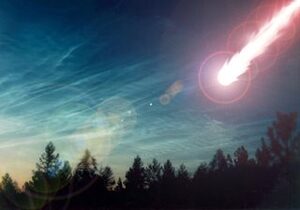 |
| ©Unknown |
| How the Tunguska object may have appeared. |
One hundred years ago today, on the night of 30 June and 1 July, one
of the most extraordinary events in modern history occurred.
The first reports of a strange glow in the sky came from across
Europe. Shortly after midnight on 1 July 1908, Londoners were intrigued
to see a pink phosphorescent night sky over the capital. People who had
retired awoke confused as the strange pink glow shone into their
bedrooms. The same ruddy luminescence was reported over Belgium. The
skies over Germany were curiously said to be bright green, while the
heavens over Scotland were of an incredible intense whiteness which
tricked the wildlife into believing it was dawn. Birdsong started and
cocks crowed - at two o'clock in the morning. The skies over Moscow
were so bright, photographs were taken of the streets without using a
magnesium flash. A captain on a ship on the River Volga said he could
see vessels on the river two miles away by the uncanny astral light.
One golf game in England almost went on until four in the morning under
the nocturnal glow, and in the following week The Times of London
was inundated with letters from readers from all over the United
Kingdom to report the curious 'false dawn'. A woman in Huntingdon wrote
that she had been able to read a book in her bedroom solely by the
peculiar rosy light. There were hundreds of letters from people
reporting identical lighting conditions that went on for weeks... (Tom Slemen)
None of the people witnessing this strange phenomenon had any idea
that, in the central Siberian plateau, just after 7:15 a.m. local time,
the planet had been hit by a cometary impactor that exploded - as most
such impactors do - in the atmosphere just above the Earth's surface.
There was, of course, a great deal of comment about the strange,
glowing sky in newspapers and scientific journals at the time. A theory
was proposed that icy particles had somehow formed high in the
atmosphere and were reflecting sunlight. Another theory suggested that
a strange auroral disturbance was involved. The Danish astronomer Kohl
pointed out that several very large meteors had recently been observed
over Denmark and he suggested that comet dust in the high atmosphere
might account for the phenomenon. He was getting close, but in general,
there was no agreement as to what had happened.
An Irkutsk newspaper dated 2 July reported that, in a village more
than 200 miles from the Tunguska river, peasants had seen a fireball
brighter than the sun approach the ground, followed by a huge cloud of
black smoke, a forked tongue of flame and a loud crash as if from
gunfire.
All the villagers ran into the street in panic. The old women wept and everyone thought the end of the world was approaching.
Nearly 400 miles south-west of the explosion, at 7:17 a.m. on 30
June, a train driver on the Trans-Siberian express had to stop his
train for fear of derailment due to the tremors and commotion. In towns
300 to 400 miles away, hurricane-like gusts rattled doors, windows and
crockery. This was followed within minutes by shock waves which knocked
down horses and hurled people working on boats into the river.
Over 550 miles to the south of the explosion, a seismograph in the
city of Irkutsk near Lake Baikal, close to the Mongolian border,
registered strong earth tremors.
Local Siberian newspapers carried stories of a fireball in the sky,
and a fearful explosion, but by the autumn of 1908 these stories had
died out, and they went unnoticed in St. Petersburg, Moscow and the
West. The region was arguably one of the most inaccessible places on
Earth, in the center of Siberia.
The closest observers of the explosion were reindeer herders asleep
in their tents in several camps about 30 km from the site. They were
blown into the air and knocked unconscious; one man blown into a tree
later died of his injuries.
Early in the morning when everyone was asleep in the tent, it was
blown up in the air along with its occupants. Some lost consciousness.
When they regained consciousness, they heard a great deal of noise and
saw the forest burning around them, much of it devastated.The ground shook and incredibly prolonged roaring was heard.
Everything round about was shrouded in smoke and fog from burning,
falling trees. Eventually the noise died away and the wind dropped, but
the forest went on burning. Many reindeer rushed away and were lost. [earthsci.org]
Thousands of reindeer, in the general area around ground zero, were
killed. Many campsites and storage huts belonging to the herders that
dotted the area were destroyed.
Rumors of an extraordinary event persisted, transmitted back by
geologists and other researchers working in the area. These stories
attracted the attention of a meteorite researcher, Leonard Kulik. But,
it was not until 1927 that he could finally lead an expedition to the
site of the 1908 explosion.
Kulik got off the Trans-Siberian railway at the Taishet station and
on horse-drawn sledges they set off on an arduous three-day odyssey
through 350 miles of ice and snow until he and his men reached the
village of Kezhma, situated on the River Angara. At the village Kulik
and his party of researchers replenished their supplies of food, then
struggled on for a three-day journey across wild and unchartered areas
of Siberia until they reached the log-cabin village of Vanavara on 25
March.Kulik then tried to make headway through the untamed Siberian
forests, or taiga as the Russians call it, but was forced to turn back
after heavy snowdrifts almost froze the horses to death. For three days
Kulik was forced to remain in the snow-bound village of Vanavara, but
during this period he interviewed many of the Evenki hunters who had
witnessed the Siberian fireball's arrival on this planet.The tales of the sky being ripped open by a falling sun and of a
great thunder shaking the ground made Kulik even more eager to
penetrate the taiga to find his holy grail.When the weather gradually improved, Kulik set out for the Tunguska
Valley. When he finally reached the site of the mysterious explosion,
he was almost speechless. From a ridge overlooking the scene, Kulik
took out his notebook and scribbled down his first impressions of the
damage wreaked by the cosmic vandal. Kulik wrote:
From our observation point no sign of forest can be seen, for
everything has been devastated and burned, and around the edge of the
dead area, the young, twenty-year-old forest growth has moved forward
furiously, seeking sunshine and life. One has an uncanny feeling when
one sees twenty to thirty-inch [thick] giant trees snapped across like
twigs, and their tops hurled many yards away.
©Unknown
Aftermath of the Tunguska explosion
There were three further expeditions to the site of the Tunguska
explosion, all of them headed by Kulik. In 1941, Hitler attacked
Russia. The 58-year-old Leonid Kulik volunteered to defend Moscow, but
was wounded by the Nazis. He was captured by German troops and thrown
in a prison camp where he died from his wounds. [Tom Slemen]
The energy of the explosion has been calculated from the extent of
the flattened forest and from the small pressure waves which arrived at
the speed of sound and were recorded on barographs around the world
including stations between Cambridge, 50 miles north of London, and
Petersfield, 55 miles south. Interestingly, it took the meteorologists
in England twenty years to make the connection between their records
and the devastation in Tunguska. The wave trains were unlike any others
which had been recorded up until that time but nowadays we know that
they do resemble those obtained from a hydrogen bomb explosion. It
seems that the impact had an energy of 30 to 40 megatons, the combined
force of a few dozen ordinary hydrogen bombs.
According to John Baxter and Thomas Atkins, in their book The Fire Came By,
the explosion resulted in an enormous "pillar of fire" and the blinding
column was visible for hundreds of miles. The series of thunderous
claps that followed could be heard for 500 miles or more.
 |
| ©Unknown |
| What the Tunguska explosion may have looked like. |
The noise of the explosion deafened those close to the blast.
Following that, a searingly hot thermal current from the fire in the
sky raced across the forests. Tall conifers were scorched and ignited
and the fires burned for days. Residents of Vanavara, a small trading
post about forty miles distant, felt the fierce draft of heat. Some
individuals there were flung into the air as the shock wave arrived;
pieces of sod were gouged up, ceilings collapsed, and windows were
shattered.
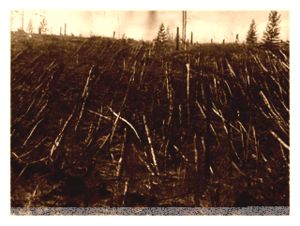 |
| ©Unknown |
| Aftermath of the Tunguska explosion |
As it happens, the date of fall, 30 June, corresponds to the passage
of the Earth through the maximum of the Beta Taurid stream. From this
and its trajectory, it appears that the Tunguska object was part of the
Taurid complex. Probably the Earth passed through a swarm within the
stream.
The scientific investigation undertaken by Kullik in 1927 revealed
that near the center of the blast many of the trees were still standing
upright, even though denuded of limbs and leaves. Further from ground
zero the trees were blown down and seared, forming concentric circles
with the bases of the trees all pointing in the direction of the center
of the blast. All of this evidence pointed to the fact that the blast
almost certainly occurred in mid air.
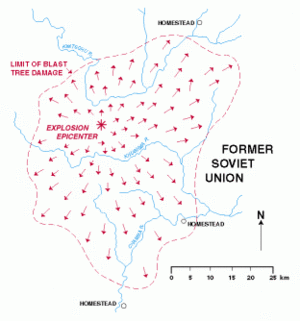 |
| ©Unknown |
| This image shows the directions of the blast |
The occurrence, this century, of an impact with the energy of a
really big hydrogen bomb does give one pause. Had the incident occurred
today, it would probably trigger World War Three. Just a few hours
earlier or later and the impact could have been over a major city or
urban area. But that didn't happen. As noted, it was twenty years
before anyone really had an inkling of what DID happen. That was partly
due to the fact that the Russians in 1908 were somewhat occupied with
politics. The previous year, 1907, Czar Nicholas had found himself
faced with revolutionaries being elected in large numbers to the newly
created parliament - the Duma. The eventual revolution began in 1918.
One might even say that the Tunguska event was a harbinger of things to
come. And maybe in more ways than anybody thinks.
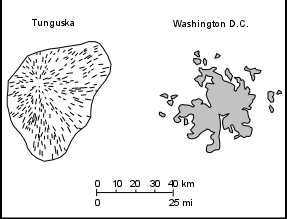 |
| ©Unknown |
| This diagram shows the area of damage in Tunguska as compared to the size of Washington D.C. |
Eighty-six years later, in July of 1994, there was another harbinger: the fragments of Comet Shoemaker-Levy struck Jupiter.
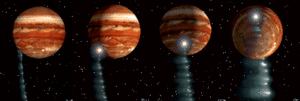 |
| ©Unknown |
If they were able to brush Tunguska off as a fluke, scientists were
not so easily able to put aside the spectacle of a whole string of
comets hitting another planet in our solar system, one after the other,
as the planet spun in space. In the same year, a book entitled Hazards due to Comets and Asteroids was published in reaction to this, then impending, event. The book is a collection of papers which I have referenced before in this series. One of the papers in that book says:
Our understanding of the history of Earth and its inhabitants is undergoing a radical change.
The gradual processes of geologic change and evolution, it is now
clear, are punctuated by natural catastrophes on a colossal scale -
catastrophes resulting from collisions of large asteroids and comets
with Earth. It is, to use the popular term, a "paradigm shift."This "new catastrophism," is not unlike the revolutions brought
about by the heliocentric solar system of Copernicus, or Darwinian
evolution, or the big bang. In retrospect, such revolutionary ideas
always seem obvious. On reading the Origin of Species, Thomas
Huxley remarked simply: "Why didn't I think of that." Now, looking at
the Moon, we find ourselves wondering why it took so long to ask
whether the process that cratered its surface is still going on.
(Robert L. Park of The American Physical Society, Lori B. Garver of the
National Space Society and Terry Dawson, a staffer for the House
Committee on Science, Technology, and Space working for the Committee's
then Chairman, Rep. George Brown )
Let me repeat that most important remark:
Our understanding of the history of Earth and its inhabitants is undergoing a radical change. The gradual processes of geologic change and evolution, it is now clear, are punctuated by natural catastrophes on a colossal scale ...
That may be the understatement of the millennium.
It has been suggested by a number of researchers that the current
"climate change" issues are actually due to the earth moving through
cosmic dust clouds and that all the hoopla about global warming is
simply a cover-up of this fact. Astrophysicist Victor Clube suggests
that it is a cometary cosmic dust cloud, left over from the break-up of
a giant comet that, for a long period of the Earth's history,
threatened and bombarded our planet with unspeakably horrible,
civilization destroying fragments, i.e. the progenitor of the Taurid
stream, including the Tunguska comet. Clube also argues that these
events were the basis for the formulation of humanity's ideas about the
cosmos, god and religion and even astrology. Over time, as the giant
comet spent most of its mass in its Titanic fury, dying away to
occasional less than civilization destroying bombardments, our
conceptions of gods changed; the reality was tossed out the window in
favor of fairy tales for both science and religion, not to mention
astrology. He writes:
Three thousand years ago, in accordance with age-old practice, the
kings of Babylon were still employing astronomer-priests to give
warnings of cosmic visitations. A thousand years ago, the emperors of
China were still relying on similar skills, while in Europe the Pope
saw messages in the sky and urged Holy War. But this latter was an
aberration; for the last two and a half thousand years have
seen the decline and fall of the sky gods, and the growing presumption
that the cosmos is stable and regular. The shift of paradigm has been
unconscious, convenient, insidious and thorough. Probably,
the rediscovery of a lost tradition of celestial catastrophe could not
have been made through analysis of ancient texts alone; a key had to be
provided, and it has been, by the paraphernalia of modern science. It
is a salutary lesson both on the capacity of human reasoning to get it
wrong for long periods of time, and on the essential unity of knowledge.It would be naïve to think, however, that one merely has to point to
deep-seated cracks in the structure of modern knowledge to have
scholars setting to and constructing a better framework within which
mankind might plan his future. There is considerable intellectual
capital invested in the status quo, enough to ensure that those with an interest in preserving it,
the 'enlightened' and the 'established', will continue to present the
cosmos to us in a suitably non-violent form. The history of ideas
reveals that some will even go further and act as a kind of thought police, whipping potential deviants into line. For them, temporal power takes precedence over the fate of the species. (Clube, The Cosmic Winter)
This problem of the "status quo" and "thought police" is not a minor
issue. In this series of articles that were kicked off by Mike
Baillie's book New Light on the Black Death,
we have repeatedly come face to face with the obvious fact that those
in positions of power and authority lie to the masses of humanity as a
rule rather than an exception.
Again and again in this series, we have discussed historical
cometary bombardments, the consequences for humanity being dire enough
to begin with, but which were then exacerbated and capitalized upon by pathological deviants,
following which the facts were covered up by lies. Worse, again and
again we have seen that the masses of humanity that suffer the most
from these assaults and manipulations appear to be quite willing to be
deceived even to their own death and destruction (if only someone will
give them something warm and fuzzy to believe in and a scapegoat to
blame). At present, we are observing this phenomenon playing out on the
global stage in real time and again and again we shake our heads and
ask "why?!" What is it about our world, our present day culture, the
human beings that occupy our planet, that gives rise to this bizarre
condition that lies are preferred over truth, death over life?
As I have pulled on the many threads that lead to and away from
these matters, what I see repeatedly is a small group of people on the
planet who rule over the masses of people, who do not have humanity's
best interests at heart - another staggering understatement, but I'm on
a roll so why stop now? What I see is the constant - and mostly
successful - efforts of this small group driving to enforce
totalitarianism in one guise or another - from politics to religion to
all fields of science - on the entire world. And again and again they
utilize disasters as a means to consolidate their power. Read Naomi
Klein's book The Shock Doctrine to get a good grip on exactly how this works now, and how it has always worked. There is nothing new under the sun!
Parallel to the growing awareness of pathology in power is the
expanding research among a few maverick scientists and researchers
showing plainly that cometary disasters are cyclic and it is altogether
possible that there are still a few big bangs left in the Taurid meteor
stream. It is also possible that there are new swarms of comets heading
our way as recent "global warming" and "moon capture" events on the
other planets seem to indicate. Something is definitely going on in our
solar system and we need to know what it is. What seems certain is that
if disasters are in our future, it will be seen by the elite as just
another opportunity to use their Shock tactics to consolidate their
power over the entire globe, never mind that there might be so few
people left that it will only amount to being a big frog in a small
pond - and possibly a frozen one at that.
In her book The Origins of Totalitarianism, Hannah Arendt
wrestles mightily with the problem, never quite reaching a complete
explanation nor solution. After all she saw, all she experienced, all
her research, in the introduction she wrote:
Two world wars in one generation, separated by an uninterrupted
chain of local wars and revolutions, followed by no peace treaty for
the vanquished and no respite for the victor, have ended in the
anticipation of a third World War between the two remaining world
powers. This moment of anticipation is like the calm that settles after
all hopes have died. We no longer hope for an eventual restoration of
the old world order with all its traditions, or for the reintegration
of the masses of five continents who have been thrown into a chaos
produced by the violence of wars and revolutions and the growing decay
of all that has still been spared. Under the most diverse conditions
and disparate circumstances, we watch the development of the same
phenomena - homelessness on an unprecedented scale, rootlessness to an
unprecedented depth.Never has our future been more unpredictable, never have we depended so much on political forces that cannot be trusted to follow the rules of common sense and self-interest - forces that look like sheer insanity, if judged by the standards of other centuries. It is as though mankind had divided itself
between those who believe in human omnipotence (who think that
everything is possible if one knows how to organize masses for it) and
those for whom powerlessness has become the major experience of their
lives.On the level of historical insight and political thought there prevails an ill-defined, general agreement that the essential structure of all civilizations is at the breaking point.
Although it may seem better preserved in some parts of the world than
in others, it can nowhere provide the guidance to the possibilities of
the century, or an adequate response to its horrors. Desperate hope and
desperate fear often seem closer to the center of such events than
balanced judgment and measured insight. The central events of our time
are not less effectively forgotten by those committed to a belief in an
unavoidable doom, than by those who have given themselves up to
reckless optimism. [...]This book [...] was written out of the conviction that it should be possible to discover the hidden mechanics by which all traditional elements of our political and spiritual world were dissolved into a conglomeration where everything seems to have lost specific value, and has become unrecognizable for human comprehension, unusable for human purpose.
To yield to the mere process of disintegration has become an
irresistible temptation, not only because it has assumed the spurious
grandeur of "historical necessity," but also because everything outside
it has begun to appear lifeless, bloodless, meaningless, and unreal.The conviction that everything that happens on earth must be
comprehensible to man can lead to interpreting history by commonplaces.
Comprehension does not mean denying the outrageous, deducing
the unprecedented from precedents, or explaining phenomena by such
analogies and generalities that the impact of reality and the shock of
experience are no longer felt. It means, rather, examining and
bearing consciously the burden which our century has placed on us -
neither denying its existence nor submitting meekly to its weight.
Comprehension, in short, means the unpremeditated attentive facing up
to...reality.In this sense, it must be possible to face and understand the
outrageous fact that so small (and, in world politics, so unimportant)
a phenomenon as the Jewish question and anti-Semitism could become the
catalytic agent for first, the Nazi movement, then a world war, and
finally the establishment of death factories. [...] or the
curious contradiction between the totalitarian movements avowed cynical
"realism" and their conspicuous disdain of the whole texture of reality. [...]The totalitarian attempt at global conquest and total domination has been the destructive way out of all impasses. Its victory may coincide with the destruction of humanity; wherever it has ruled, it has begun to destroy the essence of man. (Hannah Arendt, Summer, 1950)
Hannah's comments and observations of our world, wrung from her own
pain and experiences, have never been more poignant than today when we
face exactly what she was describing: Global Totalitarianism rising
like a mighty juggernaut with the end of humanity in sight. And never
have we seen more clearly that characteristic of the authoritarian type
Hannah also saw: "avowed cynical "realism" and ... conspicuous disdain
of the whole texture of reality." If you want to see a stunning
portrayal of this type of individual, get a copy of Lions for Lambs and watch Tom Cruise deliver a drop-dead performance.
Here at SOTT we regularly discuss the problem of pathological
deviance and how pathology can drive an individual to seek power over
others. We have brought forward the work of Andrzej Lobaczewski, Political Ponerology, and this goes a long way toward providing a framework in which the history of evil - particularly political evil - can be understood.
As far as I can tell, Hannah Arendt did not consider the problems of
pathology and how it operates in society as a corrupting element, nor
did she consider the factor that Judaism and its offspring,
Christianity and Islam, could be the carriers of the disease of
totalitarianism. In this sense, it is really important to come to the
knowledge of how religions are created
and by whom - generally pathological deviants - and how they are used,
in combination with politics, to control masses of people. This, of
course, takes us back to the problem of comets in our skies and
impacting our planet.
As it happens, after pulling on so many threads relating to the
topic, it occurs to me that comets may, indeed, have a great deal to do
with the major social problem on our planet today: psychopaths.
One might reasonably ask: Is some evolutionary process at work here?
Clearly, staggeringly large numbers of people die repeatedly when they
place their trust in lies and liars. And nearly as often do the liars
in power find themselves in difficult situations as a result of their
over-reaching and ignoring facts. Obviously, if evolution is at work
here, those individuals - and their offspring who believe lies are
ultimately eliminated from the gene pool. What happens to those who, as
Arendt suggests, try to comprehend, understand, and face the facts of
our reality, remains to be seen. As she also states, this comprehension
must not deny the outrageous, nor attempt to deduce the unprecedented
from precedent.
You see, evolutionarily speaking, psychopaths should not exist.
Throughout history it can be seen that human beings have needed to
co-operate and care about one another in order to survive and produce a
new generation that will carry on the processes of society. Most human
dynamics are based on people trying to work out their problems and come
to resolutions agreeable to the greatest number or, at the very least,
in the interactions between two people. The issue of trust is
paramount. Someone who betrays your trust is someone you cannot live or
work with. Therefore, psychopaths, who are untrustworthy should have
long ago become extinct. But that isn't the way things are. It appears,
in fact, as if psychopathy has increased!
As we can observe throughout history right down to the present day,
being the only psychopath in a group of trusting people can be a very
good thing for the psychopath. As groups get larger, they can
accommodate more psychopaths. It seems that when the number of people
carrying the psychopathy gene is small enough, those few who carry it
can achieve phenomenal breeding success. As Glenn Whitman explains it:
What's nice about this explanation is that it not only explains why
psychopaths exist, but also why we're not all psychopaths. If there are
few enough psychopaths in the population, then being a psychopath makes
sense because you'll mostly have winning confrontations with nice
people. But if there are too many psychopaths, then the gains from
taking advantage of nice people will be swamped by the losses from
confronting other psychopaths. In equilibrium, you'll get both psychos
and nice folks, with each strategy generating approximately equal
returns, and with the precise balance determined by the relative
payoffs of different interactions.
The problem is, as noted, we are living in a time when psychopathy
seems to have increased almost exponentially. Moreover, as Hannah
Arendt notes - and this was never more true than today - the broad
sweep of history indicates that the psychopaths are winning and that
means destruction for all, including the psychopaths.
Which leads us to the problem: psychopathy being what it is and
doing what it does, should certainly have brought the human race to
total destruction a long time ago IF, as a taxon, it had existed
throughout the development of humankind. And that suggests that it did
not. In fact, the studies of Marija Gimbutas indicate that there was a
time when psychopathy was not "at the top".
As far back as we can go with archaeological records; i.e. "hard
science," we find that the worship of the Great Celestial Goddess was
the act of veneration of the Universe and all within it as the living
body of the Goddess-Mother-Creatrix. This goddess was symbolized by the
double wavy lines of water - both the cosmic sea of
potential/activation, as well as the life giving moisture that emanated
from the body of the Goddess and all women as her representatives on
earth; the oceans and seas, rivers and springs and wells.
She was the sky Goddess and the Earth was her womb and all upon it
were her children. The "Son/Sun-King" died every year and was reborn in
the passing of the seasons. Rites and rituals were enacted to insure
the rebirth of the "Son-Sun" through the "womb of the Earth," the
generative organ of the Cosmic Mother. There was a purity and
innocence... a pastoral, Arcadian simplicity and symmetry to life. Men
and women were equals in importance as the "Twin offspring" of the
Goddess.
Women were honored and cherished in their three manifestations: the
virgin-future-mother; the mother-nourisher; and the crone-mother of
wisdom. Men were partners and protectors of women, thereby protectors
of their own being since all were born and nursed by women. The male
energy served the female because the female served the male; there was
cycling energy, synergy, symmetry and balance.
The wavy lines of water, the Cosmic Sea of the Mother, were, at some
point, corrupted into the symbol of the serpent; the woman became
associated with the serpent instead of the Stars; and everything went
downhill from there. This event is described in Genesis 3:19 where Adam
is told by Yahweh: "In the sweat of your face you shall eat bread till
you return to the ground, for out of it you were taken; you are dust,
and to dust you shall return."
Here, the "dust" or the Earth, is denigrated and reviled as
worthless in the same passage as woman, herself, is denigrated and
reviled as the temptress. But, in the pre-existing Goddess religions,
the earth out of which all life has been born is NOT dust, but alive -
as the womb of the Goddess herself! And, judging by the massive
evidence collected by Marija Gimbutas, this was the most ancient and
worldwide order of thought, antecedent to and underlying all other
myths, predating the male-dominated pantheons by many thousands of
years!
The main theme of the Goddess symbolism is the mystery of birth and
death and the renewal of life, not only human, but all life on earth
and indeed, in the whole cosmos. Symbols and images cluster around the
parthenogenetic Goddess and her basic functions as Giver of Life,
Wielder of Death, and, not less importantly, as Regeneratrix, and
around the Earth Mother, the Fertility Goddess young and old, rising
and dying with plant life. She was the single source of all life and
who took her energy from the springs and wells, from the sun, moon, and
moist earth. This symbolic system represents cyclical, not linear time.
In art this is manifested by the signs of dynamic motion: whirling and
twisting spirals..." [Gimbutas, 1989]
At some point the goddess, or source of moisture and all life, was
identified with the serpent-as-tempter and became the wicked Temptress
herself. There is some difficulty in untangling the threads of the
currently known symbolic systems of which there are now two: one
reflecting a matriarchal-serpent culture, and the other an
androcratic-militaristic-serpent culture. The man and woman, who were
formerly united as the original "Twins of Creation," and who, in their
union could "control" the serpent, became opposed to each other;
unbalanced; antagonists, not partners. The benevolent "Son-King," the
leader of the flock, was no longer sustained and supported by the
female energy, channeled from the Goddess through the "Tree," in the
body of the Goddess' representative on Earth, Woman, but instead became
the male "killer" of the serpent AND controller/ oppressor of the
Goddess, who became the exemplification of temptation and occasional
consort of the serpent!
At some point, the ancients say that Eve betrayed Adam, Cain killed
his brother, Abel, and psychopathy was let loose on our planet.
Who was this serpent? What are the clues that point to his appearance on the scene? Where? When?
Tunguska was the first key to this problem.
If it had not been for the cometary impact at Tunguska one hundred
years ago today, and then the Shoemaker-Levy impacts on Jupiter
eighty-six years later, our attention would not be drawn to certain
aspects of our history that have been thoroughly covered up, nor the
effects of those lies and distortions on our world today. Somehow,
psychopaths and comets are inextricably bound together; it is even
possible that the same cosmic forces that sent comets our way also
"created" psychopaths. This is what I want to explore in the final
installments to this series of articles.
Stay tuned, our next stop is the end of the Last Ice Age when the
Cosmic Serpent appeared on the scene and the processes that have led to
our involvement in the Sixth Extinction got underway.
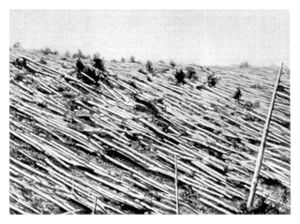
No comments:
Post a Comment